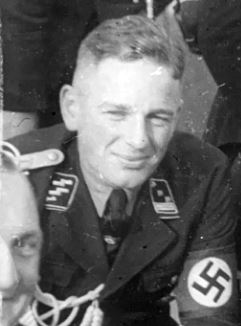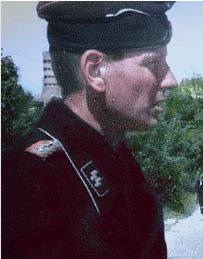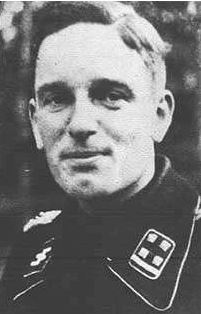Reitzenstein, Freiherr von, Albin (Waffen SS)
- Date of birth:
- March 4th, 1911 (Berlin/Prussia, Germany)
- Date of death:
- November 30th, 1943 (on the road Shitomir-Kiev, west ov Kiev, Soviet Union)
- Buried on:
- Military Cemetery Zhytomyr
Grave: UNK. - Service number:
- SS-Nr.: 4.533 // NSDAP-Nr.: 249.943
- Nationality:
- German
Biography
Albin Joseph Bodo Erdmann Freiherr von Reitzenstein
Promotions:
01.10.1933: SS-Untersturmführer
04.07.1934: SS-Obersturmführer
04.07.1936: SS-Hauptsturmführer
01.09.1941: SS-Sturmbannführer
20.04.1943: SS-Obersturmbannführer
Career:
00.05.1930: joined the NSDAP
00.01.1931: joined the SS
00.10.1933: SS-Ustuf, 1. Sturm, Leibstandarte „Adolf Hitler", SS-Stabswache Berlin
00.07.1936: SS-Hstuf, Führer, 1. Sturm, I. Sturmbann, SS-Standarte „Deutschland", SS-Verfügungstruppe
00.09.1939: SS-Hstuf, campaign in Poland
28.09.1939: SS-Hstuf, severely WIA and evacuated to a Lazarett
01.08.1940: SS-Hstuf, Taktiklehrer, SS-Junkerschule Bad Tölz
15.12.1940: SS-Hstuf, Kommandeur, SS-Aufklärungs-Abteilung 5, 5. SS-Division (mot.) „Wiking"
00.06.1941: SS-Hstuf, Operation Barbarossa
20.04.1942: SS-Stubaf, Kommandeur, SS-Panzer-Abteilung 2, 2. SS-Division „Reich" (mot.)
00.03.1943: SS-Ostubaf, Kommandeur, SS-Panzer-Regiment 2, 2. SS-Panzergrenadier-Division „Das Reich"
30.11.1943: SS-Ostubaf, KIA on the road to Shitomir, West of Kiev
Do you have more information about this person? Inform us!
- Period:
- Second World War (1939-1945)
- Rank:
- SS-Hauptsturmführer (Captain)
- Awarded on:
- September 24th, 1939
- Period:
- Second World War (1939-1945)
- Rank:
- SS-Hauptsturmführer (Captain)
- Awarded on:
- October 2nd, 1939
- Period:
- Second World War (1939-1945)
- Rank:
- SS-Hauptsturmführer (Captain)
- Awarded on:
- November 1st, 1939
- Period:
- Second World War (1939-1945)
- Rank:
- SS-Hauptsturmführer (Captain)
- Awarded on:
- 1940
- Period:
- Second World War (1939-1945)
- Awarded on:
- 1942
- Period:
- Second World War (1939-1945)
- Rank:
- SS-Sturmbannführer (Major)
- Awarded on:
- August 20th, 1942
- Period:
- Second World War (1939-1945)
- Rank:
- SS-Obersturmbannführer (Lieutenant-colonel)
- Awarded on:
- August 3rd, 1943
- Period:
- Second World War (1939-1945)
- Rank:
- SS-Obersturmbannführer (Lieutenant-colonel)
- Unit:
- Kommandeur, SS-Panzer-Regiment 2, 2. SS-Panzer-Division “Das Reich”, 4. Panzer-Armee, Heeresgruppe Süd
- Awarded on:
- November 13th, 1943
“Following the conclusion of the winter battle of 1943, SS-Obersturmbannführer Freiherr von Reitzenstein (hitherto the commander of I. Abteilung) took over command of the Panzer-Regiment.
As the Division was being reconstituted SS-Obersturmbannführer von Reitzenstein rebuilt the medium Panzer-Abteilung and the heavy Tiger Kompanie, and was responsible for creating the new III./Pz.Rgt. (T-34). To this end he restored the tank factory at Kharkov with men from his Regiment, and following much strenuous work they managed to construct the Panzers for his III. Abteilung from the captured Russian materiel. The I./Pz.Rgt. (Panther) remained in the Reich for its establishment.
The Regiment resumed operations on the 05.07.1943, and up until the 23.09.1943 it destroyed the following enemy materiel during the operations at Belgorod, the Mius, Kharkov, Kolomak and the withdrawal movements up to Krementschug:
- 839 enemy tanks
- 18 assault guns
- 334 anti-tank guns
- 32 artillery pieces
- 1 Katyusha rocket launcher
- 1 armoured car.
Thanks to superior tactics and leadership the Panzer-Regiment only suffered 57 total losses during this same time period.
During this time SS-Obersturmbannführer von Reitzenstein especially distinguished himself in the area north of Belgorod on the 08.07.1943. On this day SS-Obersturmbannführer von Reitzenstein commanded the armoured group of the Division, and his mission was to detach from the bulk of his Division (oriented towards the east) and attack towards the Psel river alongside the armoured group of the SS-Pz.Gren.Div. ‘LSSAH’. The goal of this move was to facilitate the advance of the units in the neighbouring Korps. Although the armoured group was unable to assemble all its forces in time due to the heavy defensive battles that were occurring on the same day, SS-Obersturmbannführer von Reitzenstein decided to set out anyways with the available troops on hand in order to both leave behind enough troops for the defensive battle whilst simultaneously carrying out his original mission of striking the overwhelming enemy armoured forces that had just arrived in front of the neighbouring Korps.
This independent decision led to a total success despite there being a persistent threat to the flanks. Following harsh combat a total of 53 enemy tanks were destroyed, and 10 km of ground was taken.
The outstanding personal actions of the regimental commander guaranteed the success of this extremely difficult operation. Noticeable relief was subsequently felt on the right wing of the left neighbouring Korps. A possible expansion of this success and a joint operation with the armoured group of the LSSAH (which was advancing from south to north 10 km further to the west) was countermanded, as the group was summoned back to the main area of the Division in order to assist in its precarious defensive battle.
The exemplary personal actions and flexible leadership of SS-Obersturmbannführer von Reitzenstein have also been exhibited in the other operations of the Regiment. At the Mius he and his Regiment destroyed 51 enemy tanks in the time period 30.07.-02.08.1943. On the 06.07.1943 it destroyed 81 enemy tanks during the breakthrough of the SS-Pz.Gren.Rgt. ‘Der Führer’ through the final Russian line near Lutschki. During the armoured battle near Bogoduchoff (12.-16.08.1943) the Regiment destroyed 73 tanks, and near Kolomak (12.-14.09.1943) it destroyed another 60.
I believe SS-Obersturmbannführer von Reitzenstein to be worthy of being awarded the Knight’s Cross to the Iron Cross on account of his bravery and outstanding feats of arms.”
Submitted on October 17th 1943.
Preliminary document and decoration on November 17th 1943 to Pz.AOK 4.
Sources
- Photo 1:
- Photo 2:
- Photo 3:
- - MOONEY, PETER, Waffen-SS Knights and their Battles, Schiffer Publishing, Ltd., 2012.
- Federl, C., Die Ritterkreuzträger der Deutschen Panzerdivisionen 1939-1945, VDM Heinz Nickel, Zweibrücken, Germany, 2000
- Die träger des Ritterkreuzes des Eiserne Kreuz 1939 - 1945
- Microfilm Publication A3343. US National Archives
- Albin von Reitzenstein | Gräbersuche-Online























